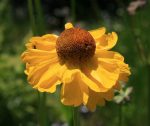 Native to moist mediows, streamsides, and marshes of California and Oregon this herbaceous perennial is a member of the aster family, Asteraceae, that also includes daisy, yarrow and lettuce. It grows 2-4.5′ tall and has mostly unbranched stems carrying glossy, lanceolate leaves that are decurrent and up to 10″ long, becoming smaller up the stem. From June to August the plants produce up to 20 solitary flowerheads that are 2-3″ wide and consist of dark yellow or brownish disc flowers surrounded by 14-20 yellow ray flowers. Each ray flower is wedge-shaped, three-toothed and reflexed. The flowerheads attract butterflies, bees and other pollinators. A good choice for a border as well as for meadow, wildflower, native plant, butterfly or rain gardens. The leaves, flowers, and seeds are poisonous to humans and livestock. The genus name, Helenium, honors Helen of Troy whose tears are said to have caused the plants to spring from the soil. The specific epithet, begelovii, honors J. M. Bigelow, a physician and plant collector who participated in the US Mexican Boundary Survey in the 1850s. The common name, sneezeweed, comes from the fact that the disc flowers and leaves were dried and used as snuff
Native to moist mediows, streamsides, and marshes of California and Oregon this herbaceous perennial is a member of the aster family, Asteraceae, that also includes daisy, yarrow and lettuce. It grows 2-4.5′ tall and has mostly unbranched stems carrying glossy, lanceolate leaves that are decurrent and up to 10″ long, becoming smaller up the stem. From June to August the plants produce up to 20 solitary flowerheads that are 2-3″ wide and consist of dark yellow or brownish disc flowers surrounded by 14-20 yellow ray flowers. Each ray flower is wedge-shaped, three-toothed and reflexed. The flowerheads attract butterflies, bees and other pollinators. A good choice for a border as well as for meadow, wildflower, native plant, butterfly or rain gardens. The leaves, flowers, and seeds are poisonous to humans and livestock. The genus name, Helenium, honors Helen of Troy whose tears are said to have caused the plants to spring from the soil. The specific epithet, begelovii, honors J. M. Bigelow, a physician and plant collector who participated in the US Mexican Boundary Survey in the 1850s. The common name, sneezeweed, comes from the fact that the disc flowers and leaves were dried and used as snuff
Type: Herbaceous perennial
Bloom: Two-three inch wide flowerheads consisting of yellow to brown disc flowers surrounded by yellow ray flowers from June to August
Size: 2-4.5′ H x 1.5′ W
Light: Full sun
Soil: Average, moist
Hardiness: Zones 7-10
Care: Divide every 2-3 years to retain vigor; may need staking
Pests and Diseases: Powdery mildew, rust, slugs, snails
Propagation: Division, seed
Companion Plants: Anenome ‘Honorine Jobert’, maiden grass, beebalm, Salvia ‘Caradonna’
Outstanding Selections: ‘The Bishop’
Photo Credit: Wikipedia